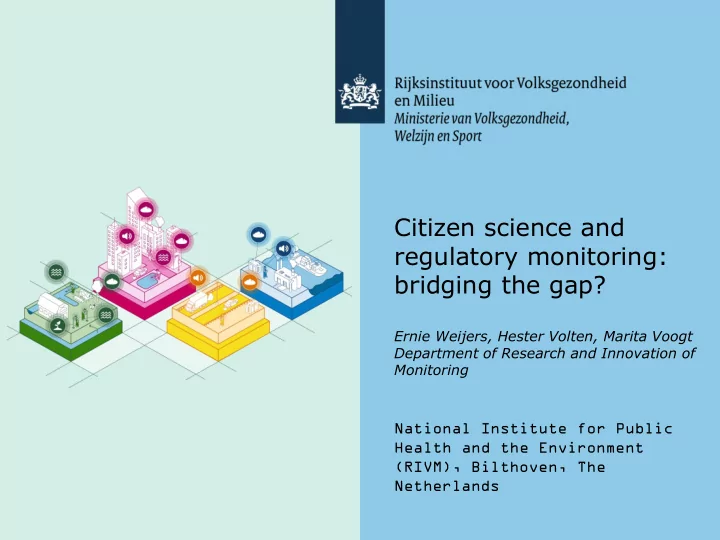

Citizen science and regulatory monitoring: bridging the gap? Ernie Weijers, Hester Volten, Marita Voogt Department of Research and Innovation of Monitoring National Institute for Public Health and the Environment (RIVM), Bilthoven, The Netherlands
Outline ● RIVM and Citizen Science ● Examples and lessons learned ● Potential benefits and challenges ● Roadmap ASIC, 13 September 2018, Oakland
RIVM and Citizen Science RIVM ● ‘Dutch’ Environmental Protection Agency ● Responsible for the National Air Quality Monitoring Network: 67 stations measuring air quality in cities, rural areas and near industry ● Dedicated research for the national and local government 2016: start program ‘ Innovation of Monitoring ‘ Why Sensors and Citizen Science? NO2 map advances in sensor technology prospect of higher spatial and temporal data resolution new ways to communicate with citizens needed ASIC, 13 September 2018, Oakland
Participating in various projects man.rivm.nl www.waag.org/en Friends of the Earth ispex.nl smartemission.ruhosting.nl ASIC, 13 September 2018, Oakland
Example 1: Simple sensors in an ammonia network The Ammonia Measurement Network in Nature Reserves measures ammonia concentrations at 82 locations on a monthly basis more than 250 tubes in total passive diffusion tube ASIC, 13 September 2018, Oakland
Example 1: Simple sensors in an ammonia network Lesson learned Trusting measurement devices to nonexperts is a cost- efficient way to build a monitoring network on a scale that would otherwise not be feasible. ASIC, 13 September 2018, Oakland
Example 2: Amsterdam Smart Citizens Lab Bottom up approach – De Waag Society Aim Citizens develop simple tools to • measure and understand their living environment Citizens involved in all steps of the • project: issue mapping sensor making sensing understanding comparison with official data decision making acting … ASIC, 13 September 2018, Oakland
Example 2: Amsterdam Smart Citizens Lab Lessons learned: Citizens want support and information from experts • Chance for success increases if experts participate • Timing is crucial: people need enough information • at an early stage Citizens may have different goals • Air Quality (NO2) mapping using sensor kits built by citizens ASIC, 13 September 2018, Oakland
Example 3 Firework experiment 2017/2018 Kits provided by RIVM Contribution of other initiatives Data portal was constructed …? NOVA SDS011 Shinyei PPD42NJ ASIC, 13 September 2018, Oakland
DIY sensor housings ASIC, 13 September 2018, Oakland
Example 3 Firework experiment 2017/2018 => More than 130 sensors online ASIC, 13 September 2018, Oakland
What people do with it … ASIC, 13 September 2018, Oakland
Recurring themes ● Citizens are motivated to contribute to air quality measurements ● They want to compare with official data ● CS offers a platform for a better communication between ‘official’ science (monitoring) and citizens ● Motivation is stronger when participants "invest" ... ● Accessible expert information is needed to support citizens, e.g. by an interactive knowledge- and dataportal ● Increasing awareness of air quality as an environmental problem Research institutes can make CS more successful but ‘management of expectations’ is needed ASIC, 13 September 2018, Oakland
RIVM and citizen science – From contradiction to synergie? Calibration Higher resolution National monitoring Citizen science ASIC, 13 September 2018, Oakland
ASIC, 13 September 2018, Oakland
Innovating a traditional measurement network towards a hybrid platform ASIC, 13 September 2018, Oakland
Example: Modelcalibration with sensor data Example of Palmes diffusion Annual average NO2 Reference s=5% BI =10 % Sensor s=8% BI =16 % Model s=13% BI =26 % Calibration points ASIC, 13 September 2018, Oakland
What's next? ● but what about the other way round: ● can science benefit fro CsS? ● Environment protection agencies can benefit(?) from citizen science using small sensor networks ● lowcost sensors (low quality data) need to be improved, and applications calibrated and validated (by reference data) ● Data needs to be assimilated, for example, in models. ASIC, 13 September 2018, Oakland
Recommend
More recommend